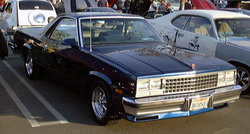Chevrolet El Camino
|
|
| Chevrolet El Camino | |
|---|---|
| Manufacturer: | General Motors |
| Class: | Car-based pickup truck |
| Production: | 1959–1960, 1964–1987 |
| First Generation | |
| Production: | 1959–1960 36,409 produced |
| Engines: | |
| Second Generation | |
| Missing image Chevrolet-El-Camino-'66.jpg 1966 Chevrolet El Camino | |
| Production: | 1964–1967 |
| Engines: | 327 in³ Small-Block V8 396 in³ Big-Block V8 |
| Third Generation | |
| Missing image Chevrolet-El-Camino-'69.jpg 1969 Chevrolet El Camino | |
| Production: | 1968–1972 |
| Engines: | 396 in³ Big-Block V8 402 in³ Big-Block V8 454 in³ LS6 V8 |
| Fourth Generation | |
| Missing image 1976_Chevrolet_El_Camino.jpg 1976 El Camino | |
| Production: | 1973–1977 |
| Engines: | |
| Fifth Generation | |

| |
| Production: | 1978–1987 |
| Engines: | 5.7 L Small-Block V8 4.3 L V6 |
The Chevrolet El Camino, a car-based small pickup truck built by Chevrolet in the United States, was produced in response to the success of the rival Ford Ranchero.
| Contents |
1959-1960: 1st generation
The first El Camino was produced for the 1959 model year (2 years after the Ranchero) and was based on that year's bewinged Chevrolet Impala. The car's development was rushed, and it was not as successful as the Ford, with 22,246 built the first year. 1960's model tracked the changes on the Impala, with an extensive restyling. Sales were a little down at 14,163 and Chevrolet decided to discontinue the model.
1964-1967: 2nd generation
Four years later, with Ford's Ranchero still selling well, Chevrolet reincarnated the El Camino, based on the new Chevrolet Chevelle platform. That 1964 model was basically identical to the Chevelle forward of the B-pillars, but Chevrolet considered the vehicle a practical, utility model and the Chevelle's most powerful engines were not available.
1965 saw the availability of performance versions of the 327 in³ (5.4 L) engine, adding up to 100 bhp (75 kW), while 1966 brought a new 396 in³ (6.5 L) engine. The El Camino followed the Chevelle's styling update for 1967, with a new grille, front bumper, and trim. Air shocks were introduced, allowing the driver to compensate for a load.
1968-1972: 3rd generation
1968 introduced a longer El Camino, based on the station wagon/4-door sedan wheelbase. A new, high performance Super Sport SS396 version was launched, alongside the Chevelle version. 1969's models were largely similar, but 1970 saw the availability of a new, enlarged 402 in³ (6.6 L) V8 replacing the 396, and Chevrolet's newest, largest engine, of 454 in³ (7.4 L), the LS6 version of which delivered 450 bhp (336 kW) and 500 lbf·ft (678 N·m) of torque, giving a stock El Camino SS454 with that engine a quarter mile time of 13.44 seconds.
1971's model saw reduced power and performance, along with the rest of Chevrolet's line, as lower-octane unleaded fuel was mandated, and emissions controls began to be felt. Single headlights replaced double for '71, and the grille came now to a point. Little changed but still lower power outputs for 1972.
1973-1977: 4th generation
For 1973, the car was restyled again, matching changes to the Chevelle. It was the largest generation of El Camino, but thanks to lighter construction, it weighed less than the previous generation. A front-end restyle with quad stacked headlights was done in 1976, but otherwise it was the same car until 1978.
1978-1987: 5th generation
A new, smaller El Camino was unveiled in 1978, with more sharp-edged styling. Since the Chevelle was no longer produced, the El Camino instead shared components with the Chevrolet Malibu and Chevrolet Monte Carlo. V6 engines were available for the first time, and from 1982 through 1984, diesel engines. After 1984, GM shifted El Camino production to Mexico for three more years; production ceased after the 1987 model year.
Engines:
South African El Caminos
The Chevrolet El Camino offered in South Africa in the 1970s was in fact a rebadged Holden Kingswood ute.
